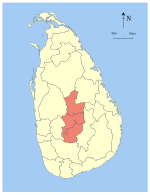This article includes a list of references, related reading, or external links, but its sources remain unclear because it lacks inline citations .(September 2010) |
 | |
| Use | Civil and state flag |
|---|---|
| Proportion | 2:1 |
| Adopted | 14 November 1987 |
| Design | Yellow lion in the center of a red square background of a white flag, with images of the Sun and the Moon to the left of the lion and two lotus flowers to the right. |
The flag of Central Province, was adopted for the Central Province of Sri Lanka on 14 November 1987.
